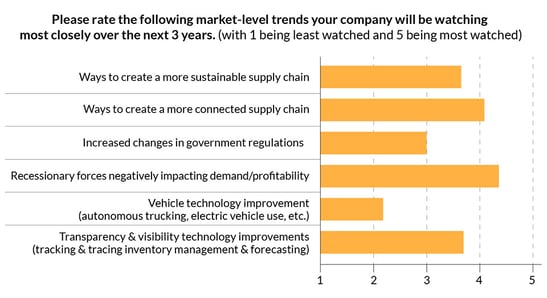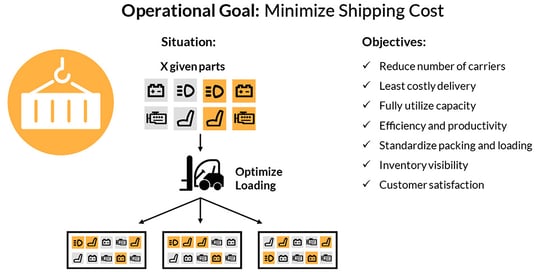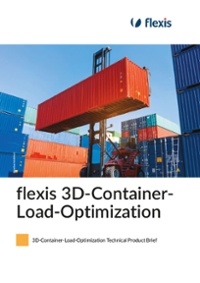Optimize Loading - Best Quick Fix for Top Shipper Priorities
Keith LaBotz - October 20, 2022

Remaining profitable in an economic recession is the most pressing issue for shippers, and one quick fix can resolve this and other top concerns.
A new survey from Freightwaves reveals the top concerns of shippers. At the top of the list is monitoring recessionary forces negatively affecting profitability.
 Source: Freightwaves
Source: Freightwaves
The survey results are hardly surprising in light of economic news:
- Bloomberg Economics went all in yesterday, declaring a US recession is 100% certain.
- Surveys from KPMG and McKinsey report over 80% of executives expect a global recession.
- Numerous economic indicators and forecasts conclude recession is imminent or in progress.
- US stocks are continuing their most prolonged quarterly decline since the 2008 financial crisis, raising concern about an asset bubble collapse.
A recession is academic at this point for supply chains, and efforts should now focus on reducing recessionary risks until the current economic cycle reverses. A reversal might take two or twenty years - no one knows how long or severe a correction will be. Until then, selecting solutions with this uncertainty in mind is one of the best moves a company can make.
Select Software that Facilitates Agile Systems Support
Shippers should not only look for software that increases agility and efficiency but also qualities facilitating agile systems support.
- Minimal IT Resources. The software is user-configurable master data, business rules, defaults, and data mapping. A good vendor will guide you in this process with their solution.
- Turnkey. No testing and no risk of failure that can disrupt operations.
- Extensible. Deployment can begin with a minimal viable feature set, so functional scope expands over time per changing demand.
- Affordable. No significant capital outlay needing budget approvals.
- Parallel Processing. Can operate alongside or fully integrated into existing processes.
- Plug and Play. Software APIs that support logistics transactions and functions can integrate into existing systems. An alternative can quickly replace the software.
- Quick Setup. The pre-production configuration of master data and default behaviors are menu-driven and follow a standardized template. A good vendor can expedite setup and manage ongoing updates without IT assistance.
- Rapid Deployment. An intuitive, graphical user interface for rapid onboarding of users and accessible to users across the enterprise.
- Scalability. Market volatility can require an operation to scale up and down quickly; software must support these swings without limit.
- Global. A multilingual user interface and country-specific business rules support worldwide deployment.
Build a Plug-and-Play Supply Chain Process
In addition to meeting the previous requirements, a plug-and-play supply chain process allows low-risk rapid response to potentially severe changes.
A recession can significantly change requirements and quickly obsolete software. A plug-and-play design allows swapping newer software to replace outdated apps with little risk.
Look For Quick Fixes
No one knows when a market correction will begin in earnest, but once it does, it will be too little too late for companies to implement protective measures.
With each passing day, less time is available for finding and implementing solutions that will increase shipper agility and efficiency. In addition to meeting the previous requirements, shippers need a quick fix: rapidly implemented software with minimal risk.
Some quick fixes solutions are much better than others, and that’s where load optimization stands out. Load optimization solutions optimize the packing and loading of shipments to minimize shipping costs.
A good solution will meet all of the objectives listed below, and these address all of the top concerns reported in the Freightwaves survey.

Loading Optimization Reduces Recession Risks
Carrier capacity can disappear overnight in a recession due to widespread carrier bankruptcies and downsizing. Carriers become more cautious about choosing customers, and they look for loyal shippers who can increase their profitability.
Shrinking demand and pessimism prevent new carriers from entering the market and existing providers from expanding. When capacity drops, securing transportation can become an expensive problem, and it often gets worse as a recession worsens.
Load optimization software minimizes shipping costs by
(1) reducing labor costs for the shipper and;
(2) improving carrier profitability, resulting in better pricing and a higher priority for the shipper.
Here are a few examples that make life better for shippers and carriers:
- Faster trailer loading reduces carrier dwell and pickup times, reducing carrier operating costs.
- Spotted trailers maintain proper weight distribution, so a carrier is not at risk for accidents.
- Compliance with hazardous material regulations prevents carrier liability for violations.
- Fragile items are not stacked, reducing expensive freight claims.
- Accurate packaging details ensure carriers arrive with sufficient equipment.
Conclusion
Shippers can remain profitable in an economic recession and address top concerns with load optimization software that meets the requirements in this article.
flexis AG offers a load optimization solution fitting the description in this article, and we welcome a discussion on how it can benefit your company.
Interested in more information? Get Your 3D-Container-Load-Optimization Technical Product Brief and learn:
-
Key Objectives and Features of 3D-Container-Load-Optimization
-
Benefits, Potential and Outcomes
-
Overview of flexis 3D-Container-Load-Optimization UI
LATEST POSTS
- Understand Why Production Planning Needs Specialized Solutions
- Understand Circular Economy in The Manufacturing Industry
- How Can Industry 4.0 IT Integration Be Achieved Smoothly?
- The Significance of Order Sequencing in Discrete Manufacturing
- How to improve your Supply Chain Management: The Power of Control Towers



